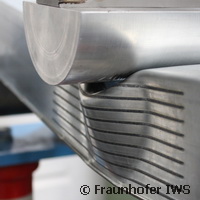Bolstering the Automotive industry with lightweight, crash-safe cars
Designing lightweight and crash-safe vehicles is one of the main pressures facing the highly competitive automotive manufacturing industry. Environmental concerns and public opinion increasingly reveal the need for car manufacturers to drive away from heavy fuel guzzling cars to lighter, fuel efficient models. The trade off between lightweight and crash-safe vehicles is in part responsible for the rising popularity of hybrid cars on Europe's roads, though the need to meet European carbon emission legislation while cutting manufacturing costs has led to the development of a lightweight construction technology that makes it possible to reduce vehicle weight while ensuring adequate crash safety. The innovation, developed by researchers working at the Fraunhofer Institute for Material and Beam Technology IWS in Dresden, Germany targeted the divergent objectives of a lean vehicle design that maintains the safety of vehicle occupants by employing a new 'local laser reinforcement' approach. This method involves using low-cost, low-strength steel sheets with minimized wall thickness and reinforcing them locally in areas that are subject to strong stresses. To do this, the experts guide a focused laser beam over the surface of the unprocessed sheet that begins to melt the treated areas before solidifying again. The heat dissipates quickly into the adjacent cold material, causing the track to cool down rapidly which results in a stronger material. 'We obtain strengths of up to 1,500 MPa (megapascals). That's roughly twice the strength of the unreinforced basic material,' says Markus Wagner, a scientist at the IWS. 'This enables us to optimize the weights and stresses above all in the design of the front and rear bumper beams, the B-pillar, and various stiffeners', he continues. Until now, vehicle bodies have consisted largely of a homogenous sheet steel structure with constant component sheet thicknesses. Components that are subject to particularly strong local stresses are often oversized because the wall strength has to be designed to withstand the highest local stress points. This means that the sheet thickness is greater than needed in areas that are subject to less impact, making components unnecessarily heavy. Moreover, car manufacturers use expensive, high-strength steel sheets resulting in a continuous compromise between component weight, component cost, and crash safety. 'Safety and lightweight construction need not to contradict each other,' says Wagner. In order to bridge the gap between the characteristics of body components and the stresses that act on them, the engineer and his colleagues are striving to obtain greater resistance to the structural damage caused to components in accidents by simulating collisions. The less the car body part bends, the greater protection the driver has. To this end, the researchers have to determine the optimum position and geometry of the reinforcement tracks. 'With our simulations, we are able to model field tests. The results obtained from trials and simulations deviate just a few millimeters from each other,' says Wagner. With the aid of numerical simulation, the scientist and his team have developed a crash-optimized track design for accidents that might arise when a car collides head-on with a tree or is hit by another car from the side. The track design was transferred onto real components using a laser. 'We managed to halve the deflection of a locally laser reinforced pipe profile compared to the reference part, even though we locally reinforced only three percent of the component volume. In other words, we doubled its crash performance,' explains Wagner. The IWS researchers have already applied their technology to various crash profiles and seat components using their new impact specific design to make components up to 20 percent lighter without neglecting crash safety.For more information, please visit:Fraunhoferhttp://www.fraunhofer.de/en.html
Countries
Germany



